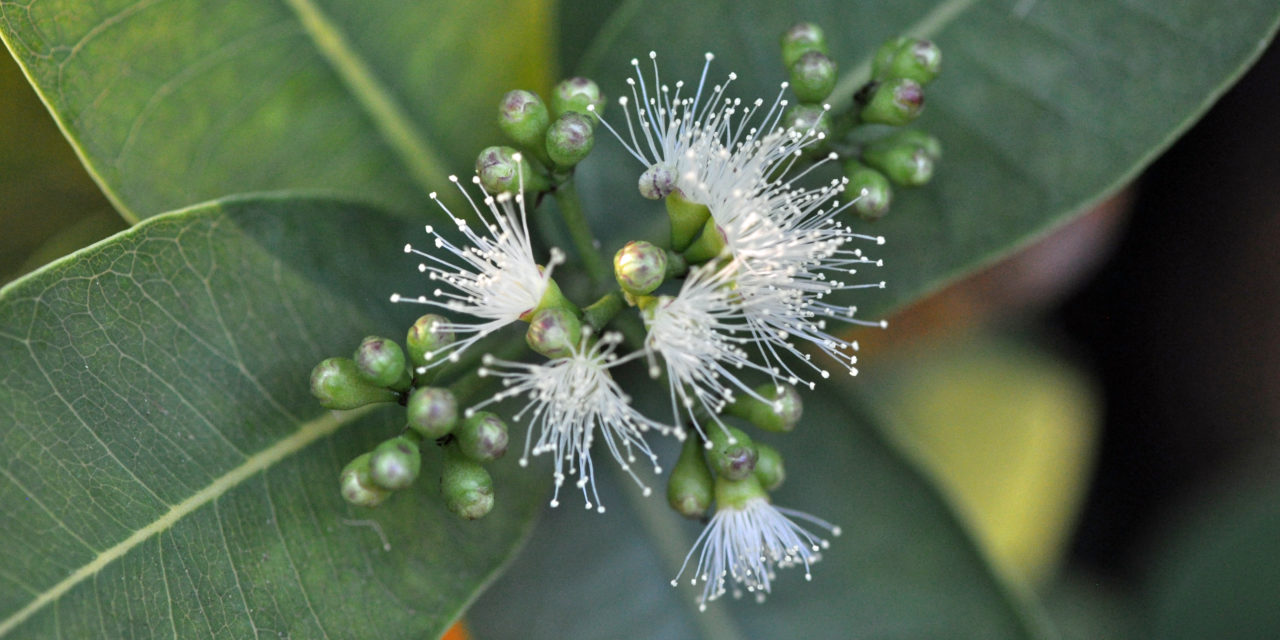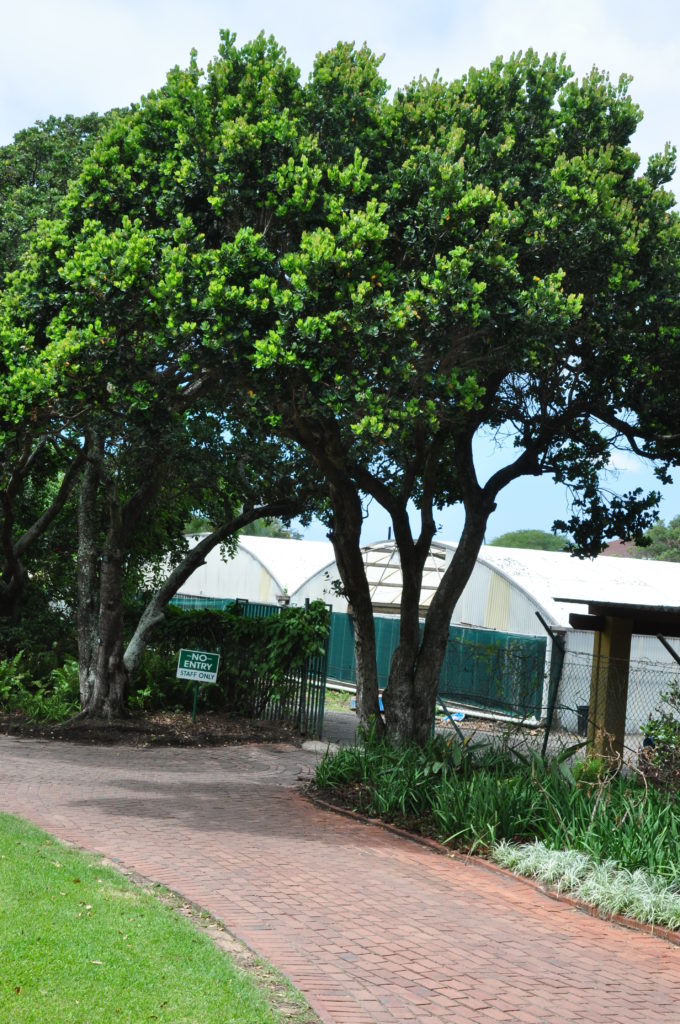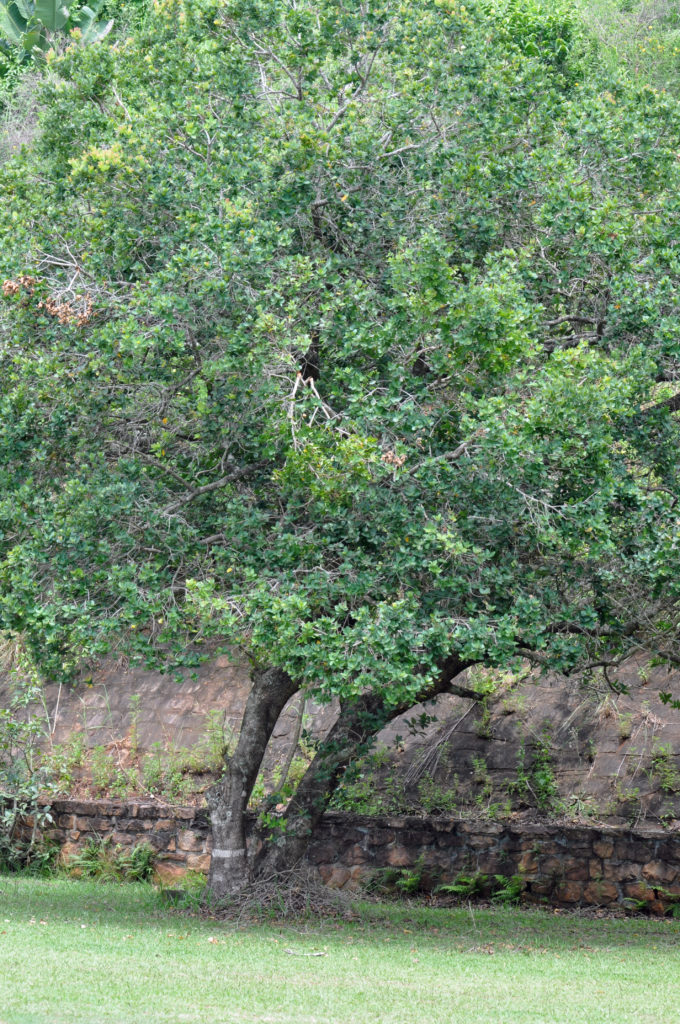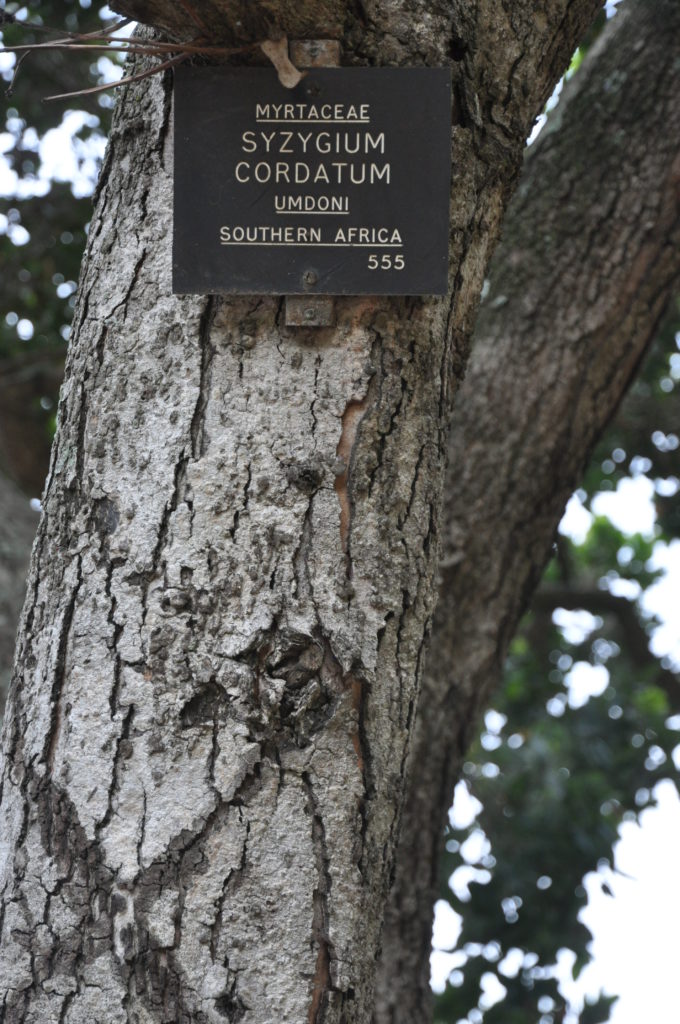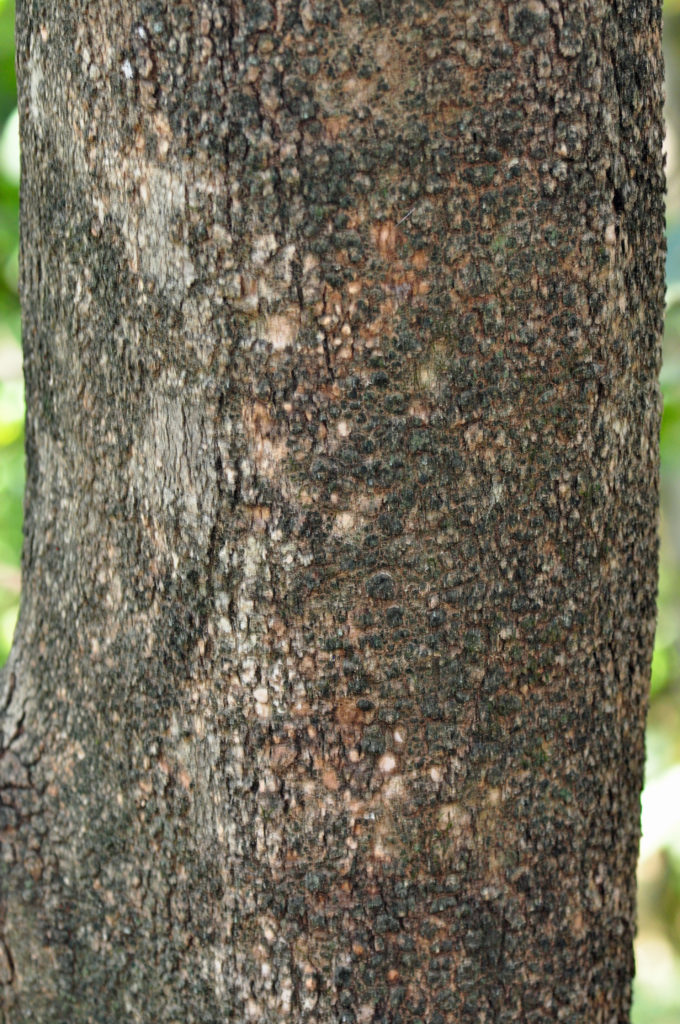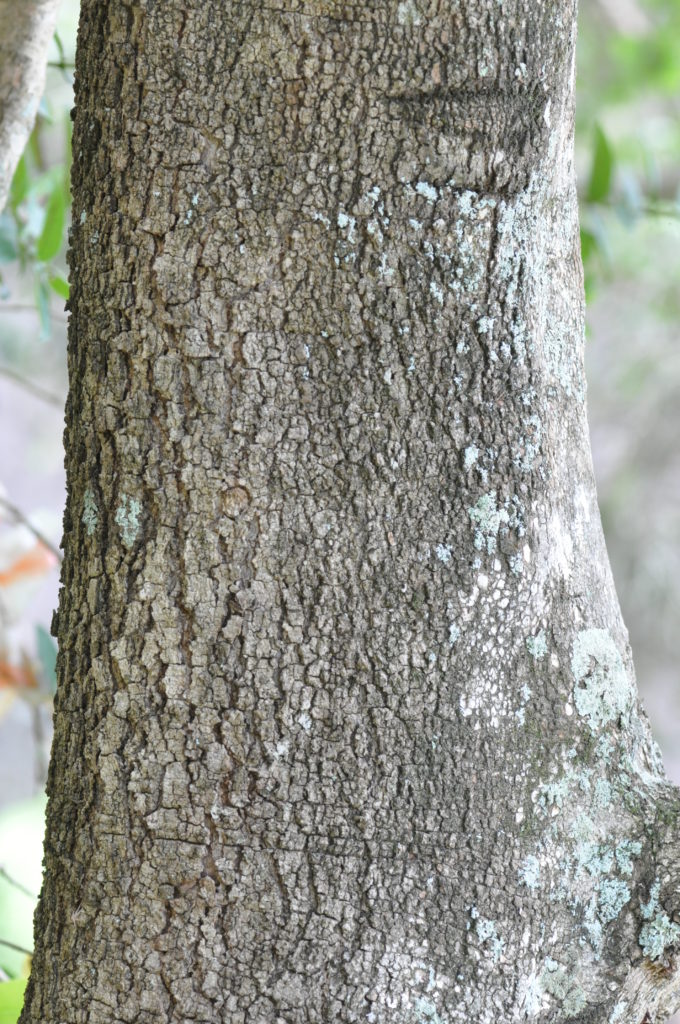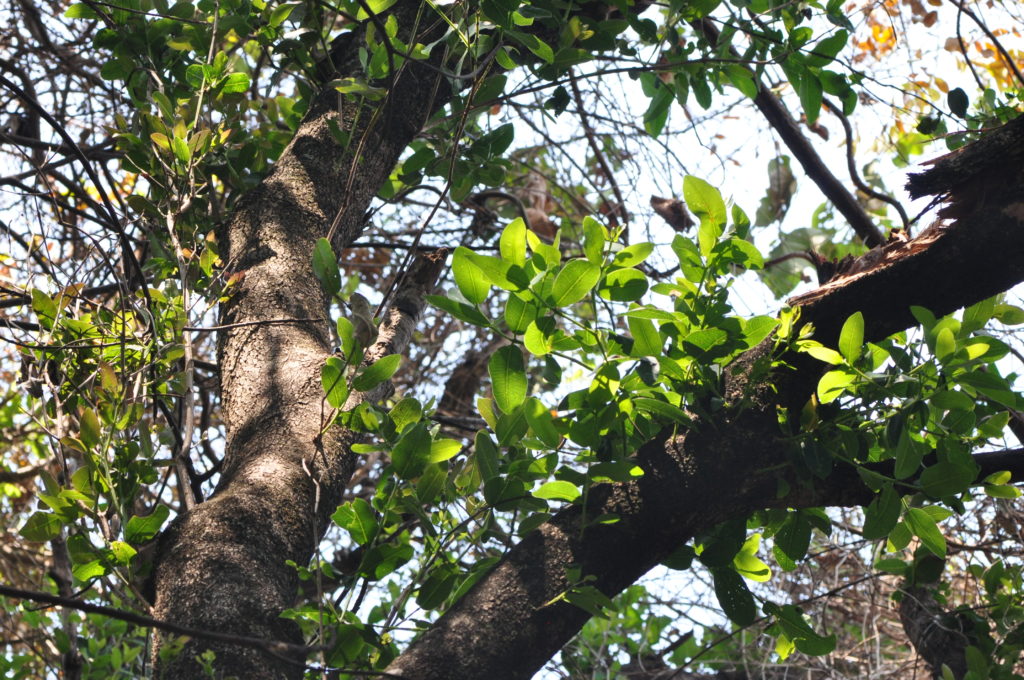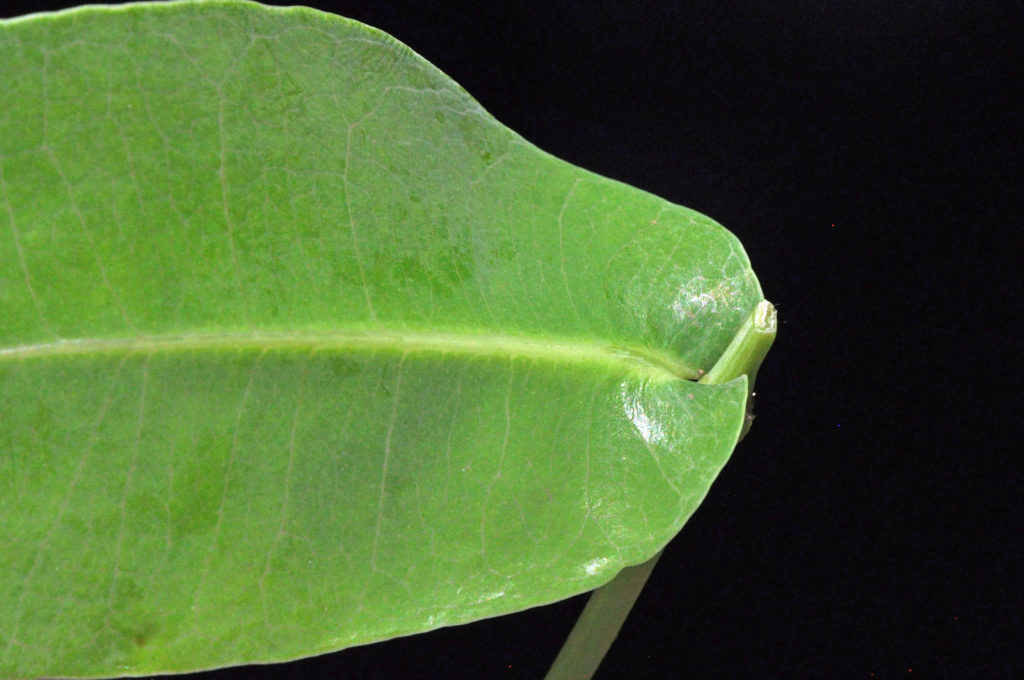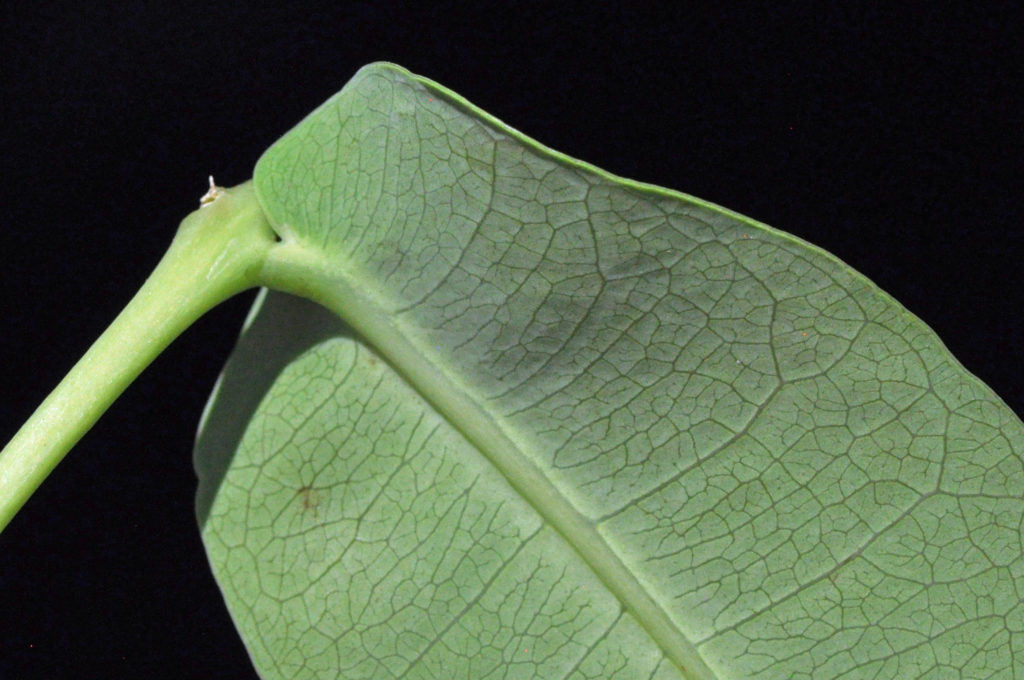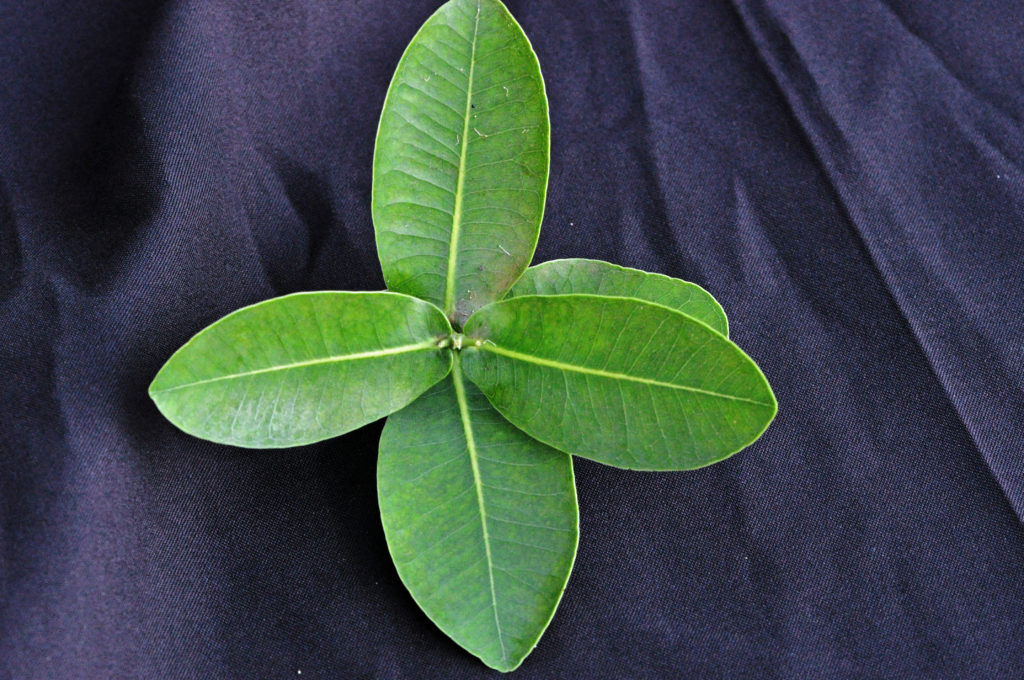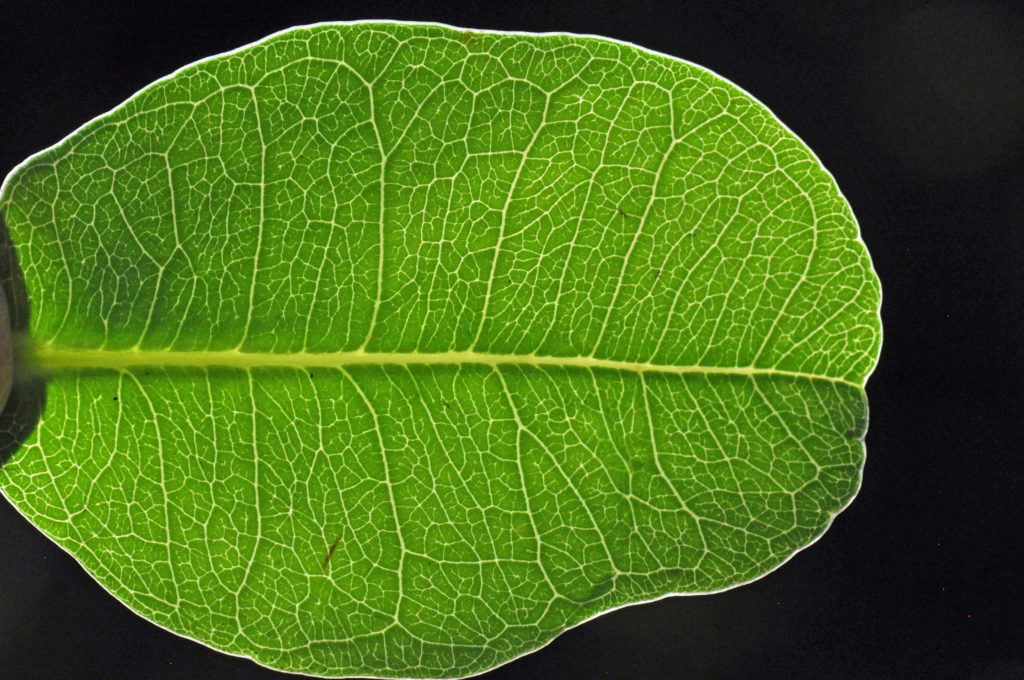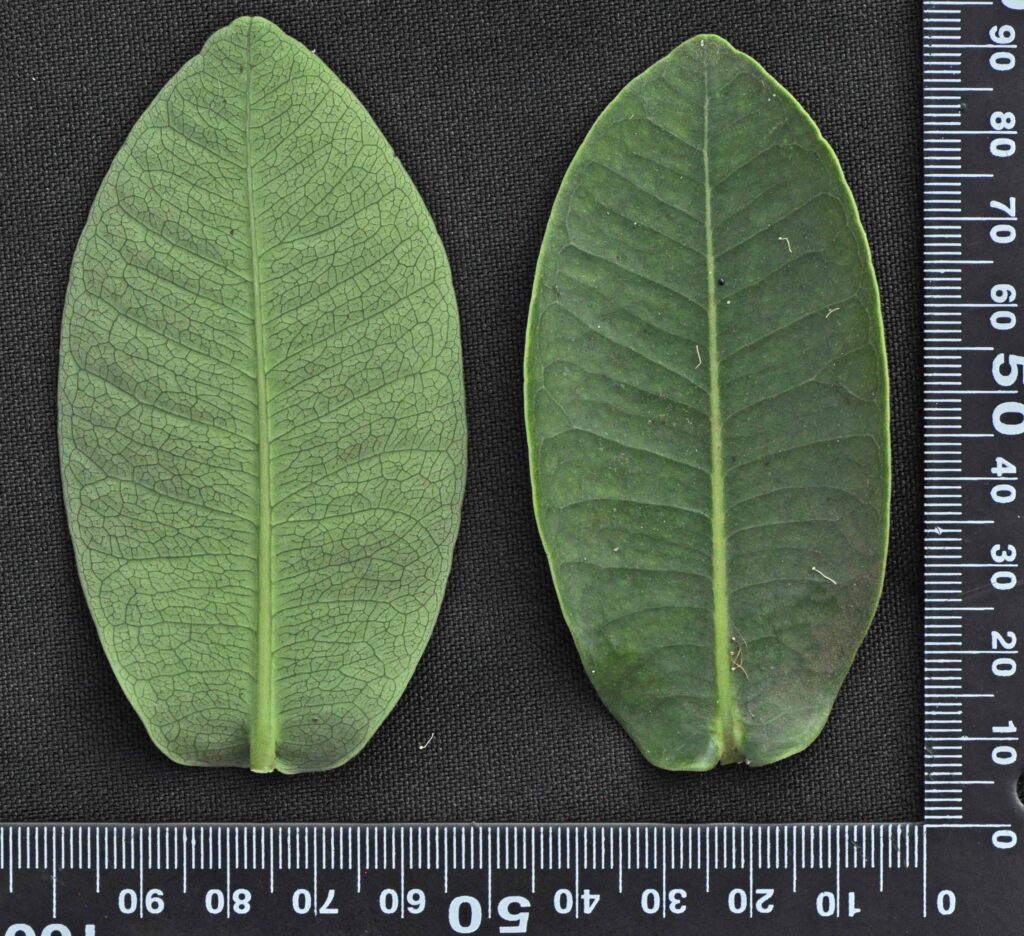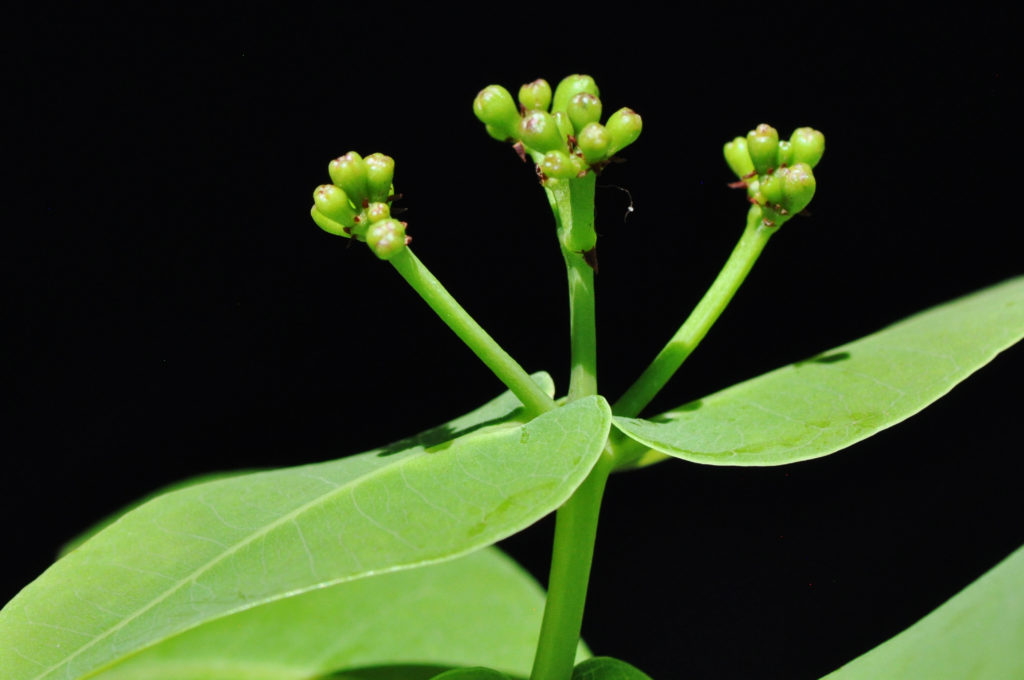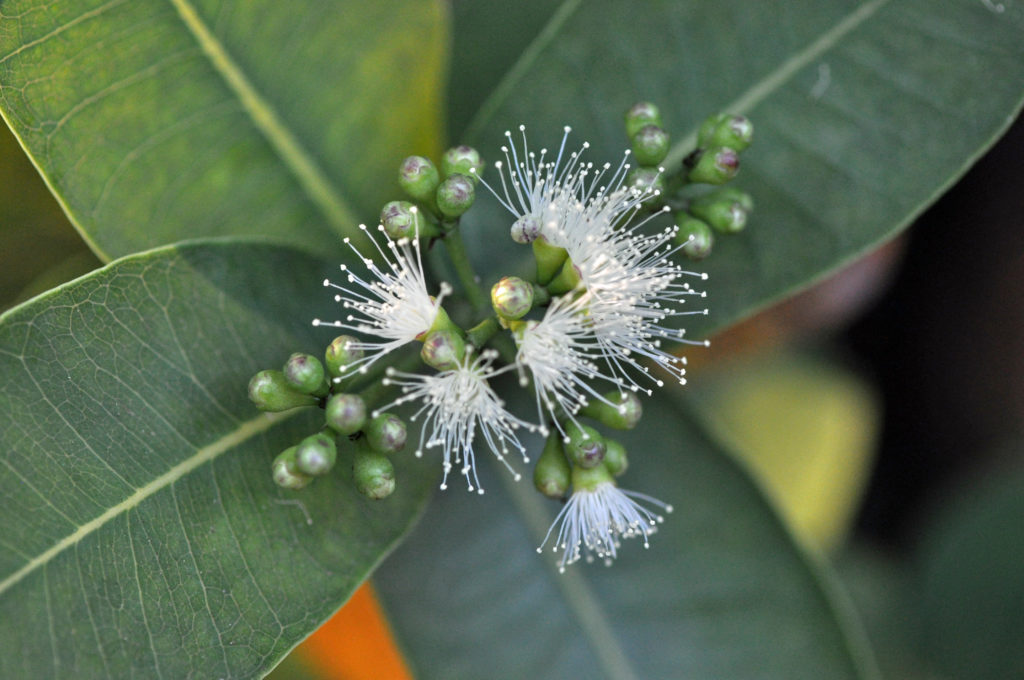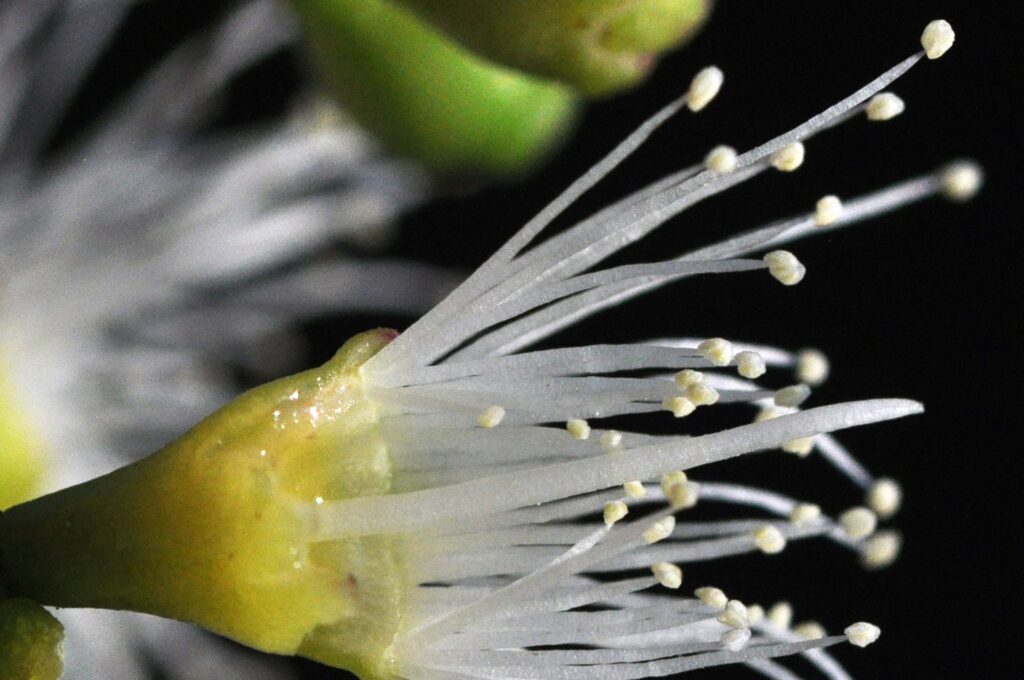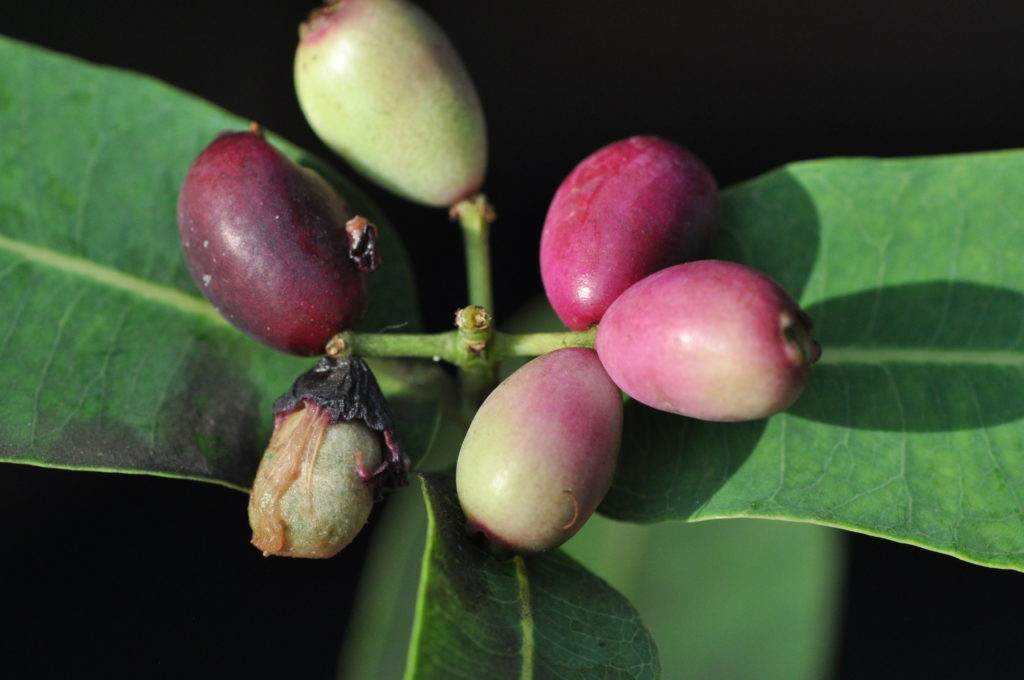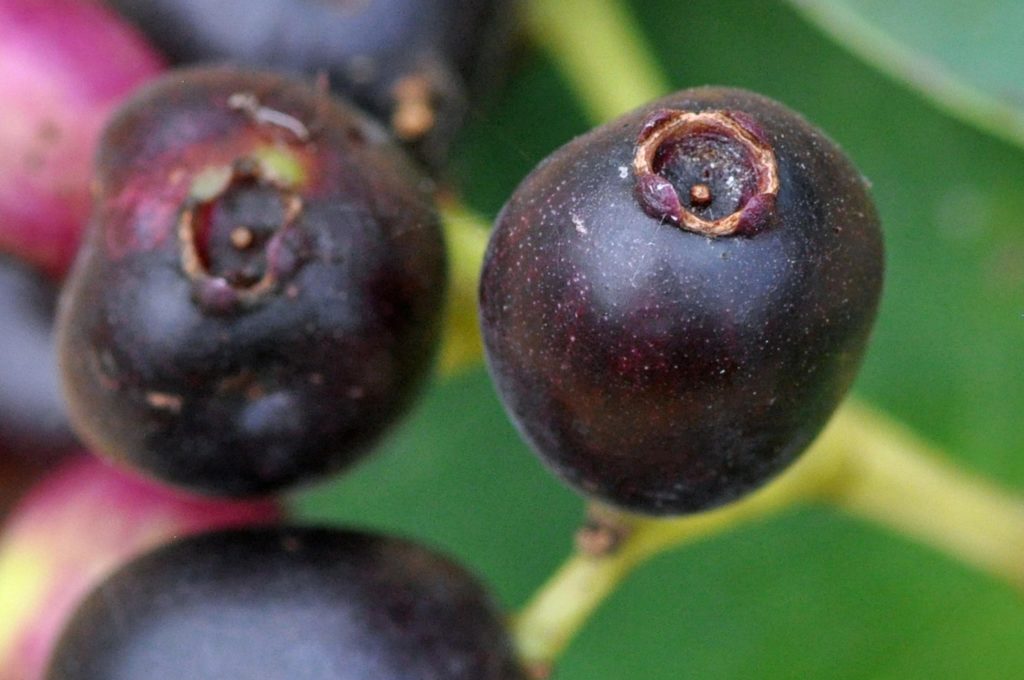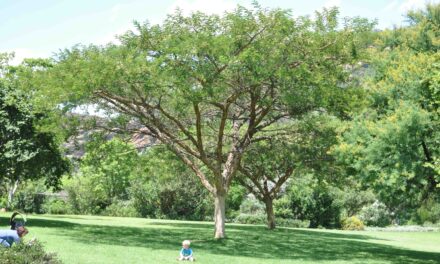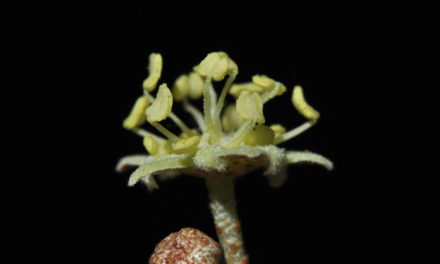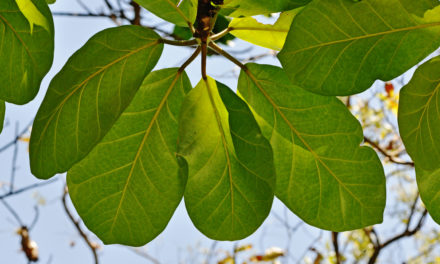General Info – summary
This evergreen Tree has corky bark, is up to 20m high and the stem may reach 0,8m wide. Young stems are 4-angled. Simple, smooth, leathery, hairless and entire Leaves are decussate. Sweet scented, bisexual Flowers are regular, each with many, long distinctly white exserted stamens. Inferior 2-locular ovary has 1 style. Edible Fruit is usually a one seeded berry ending with the visible remains of the now terminal calyx.
Description
Syzygium cordatum subsp. cordatum
Previous Names: Eugenia cordata.
SA Tree No. 555.
Common names: (Afr) Waterbessie, Waterbessieboom, Warerboom, Waterbos, Waterhout, Waterhoutboom, Without, Withoutboom, Witwaterhout. (Eng) Umdoni, Water Berry, Water Wood. (isiXhosa) Umdoni, Umjomi, Umswi. (isiZulu) Umdoni. (Northern Sotho) Monhlo. (Setswana) Mawthoo, Mawtoo, Motlho, Motu. (siSwati) Umcozi. (Tshivenda) Mutu. (Xitsonga) Andoni, Muhlwa, Muthlu, Muthwa.
Family: Myrtaceae (Myrtle and Eucalyptus family) has 130+ genera and 3 000+ species and includes the Australian genus Eucalyptus, as well as guava and clove. These mostly evergreen trees have simple Leaves that are leathery, usually entire, gland-dotted and usually opposite. Stipules are very small or absent. Flowers are regular, usually bisexual and 4 or 5-merous. However, petals may be small or absent. The many Stamens are inflexed in the bud and Anthers are 2-thecous (with 2 pollen sacs). They usually open by lengthwise slits. The usually inferior Ovary has a simple Style with a capitate Stigma. The Fruit is a capsule or berry with a persistent Calyx. Local genera with trees on this website include Eugenia, Heteropyxis, Metrosideros (Western Cape) and Syzygium.
Name derivation: Syzygium – refers to the opposite pairs of leaves that are decussate (have successive pairs at right angles to each other i.e. rotated 90 degrees along the stem when viewed from above). cordatum – heart shaped – referring to the deeply lobed leaf base. This plant may hybridise making identification difficult. There are 6 species of the genus Syzygium in southern Africa.
Conservation: National Status: L C. (Least Concern). Assessment: 2005 (W. Foden and L. Potter).
Tree
This medium to large Tree with its dense sturdy round and spreading crown (photo 206) may reach 20m high (usually less). The Stem that may be straight or crooked and the trunk diameter is up to 0,8m. It can also be a suffrutex (low-growing dwarf form) occurs and is a woody shrub or perennial with a woody base that may reach 0,5m high. The usually straight, sometimes crooked (photo 658) Stem (trunk – main axis of the plant, the leaf and flower bearing as distinguished from the root-bearing axis) may be forked. The distinctly 4-angled Twigs are smooth and hairless. Bark is fairly smooth to rough and may be blotched with grey and white. In old trees (photo 659), the bark is light to dark grey to brown, reddish, thick and corky. Net-like fissures that can be pulled off may be present. Pencil-thin Pneumatophores (specialized respiratory aerial roots extending above the ground) may be visible from the base.
- 206. 2015/02/09. Durban BG. Photo: David Becking.
- 69. 2015/02/12. Vernon Crookes NR. Photo: David Becking.
- 203. 2015/02/09. Durban BG. Photo: David Becking.
- 659. 2014/09/13. Lowveld NBG. Photo: David Becking.
- 68. 2015/02/12. Vernon Crookes NR. Photo: David Becking.
- 658. 2014/09/13. Lowveld NBG. Photo: David Becking.
Leaves
This evergreen tree produces Leaves near the ends of branches that are hairless and simple (have a single blade that may have incisions that are not deep enough to divide the blade into leaflets). These leaves are smooth, leathery and occur in large numbers. Young stems are 4-angeld and here the leaves are Decussate (opposite pairs of leaves have successive pairs at right angles to each other i.e. rotated 90 degrees along the stem when viewed from above – photo 842). Leaves are usually longer than 3cm and wider than 1cm and may reach 11 x 7cm. The Petiole (leaf stalk) is absent or very short. The leaves are not held stiffly erect (photo 216). The Shape may be oblong, nearly circular, elliptic or broadly ovate. Young leaves are red or pinkish and mature to bluish green or dark green above and a lighter green below (photo 849). The Margin may be wavy and is entire (with a continuous margin, not in any way indented). Net-Veins are more visible below (photo 216). The Lateral veins are visible on both sides, may be nearly at right angles to the conspicuous Midrib, but curve and join before reaching the margin (photo 219). Only the midrib is clearly visible on both sides. All veins are visible on this translucent leaf when held against a strong light (photo 219). Here a hand lens will help. The blade has inconspicuous gland dots. The Apex is notched, bluntly tapering, rounded or acute. The Base is rounded, deeply lobed and decurrent (leaf blades that partly wrap or have wings around the stem or petiole – photo 215).
- 215 2016/10/05 Pretoria NBG. Photo: David Becking.
- 216 2016/10/25 Pretoria NBG. Photo: David Becking.
- 842. 2017/11/14. Pretoria NBG. Photo: David Becking.
- 219. 2016/10/25. Pretoria NBG. Photo: David Becking.
- 849. 2017/11/14. Pretoria NBG. Photo: David Becking.
Flowers
Sturdy buds (photo 206) give rise to the sweetly scented, bisexual Flowers that occur in heads near the ends of branches and are actinomorphic (Regular, symmetrical. They are vertically divisible into similar halves by more than 1 plane passing through the axis). The creamy-white or pale pink flowers produce much nectar and occur in dense branched terminal heads up to 10cm in diameter. The Calyx has smooth, green Sepals with short lobes – up to 9mm long. The Corolla contains 4-5 creamy white to pink Petals that have overlapping edges and fall early.
Many impressive white exerted Stamens are visible. Each is up to 2,5cm long. These stamens are much longer than the sepals and are clearly visible because of the early falling petals. The Anthers are versatile (hung or attached near the middle, and usually moving freely – photo 847). They each have 2 thecae (pollen sacs) which usually open through lengthwise slits. There is a single Pistil (a unit of the Gynoecium, the female element of the flower, composed of the Ovary, Style and Stigma) with an inferior 2-locular Ovary containing a few ovules in each locule. The single Style (more or less elongated part of the pistil situated between the ovary and the stigma) is slightly thickened, flattish and ends with a single Stigma (the part of the pistil that receives the pollen – photo 847). (Aug-Mar).
- 206. 2106/10/25. Pretoria NBG. Photo: David Becking.
- 834. 2017/11/14. Pretoria NBG. Photo: David Becking.
- 847. 2017/11/14. Pretoria NBG. Photo: David Becking. Partially dissected.
Fruit
The single, fleshy Fruit (photo 868) has white flesh and is an oval Berry (pulpy, indehiscent fruit like a grape or tomato) – mainly enclosed in the remains of the calyx tube which resembles a small crown at the end of the mature fruit (photo 65). The berry retains 1 locule by abortion. The fruit is up to 2 x 1cm and turns red to dark purple or black when mature. Usually, each fruit produces a single Seed. (Oct-Jun).
- 868. 2018/03/01. Pretoria NBG. Photo: David Becking.
- 65. 2015/02/12. Vernon Crookes NR. Photo: David Becking.
Distribution & Ecology
These trees are nearly always Located close to water in wooded grasslands, bushveld (a sub-tropical woodland ecoregion of southern Africa), in riverine and swamp forests. They may occur in groves (small group of trees reducing the shade and resulting in little or no undergrowth). These plants are commonly located from sea level to an altitude of 1 600m in places where the rainfall range is 75-120cm per year. This tree may become Invasive. Ferns and creepers may grow up the tree bole (the main wooden axis of a tree). This tree is resistant to fires but less so to frost. Geographically they occur Eastern Cape, KwaZulu-Natal e.g. Scottburgh golf course, Mpumalanga and Limpopo. Beyond South Africa, they occur in Swaziland, Mozambique, Namibia e.g. Caprivi Strip and northwards to include Kenya. It is a food plant for larvae of the Apricot Playboy (Deudorix dinochares). These butterfly larvae feed on the Seeds within the pods. Larvae also feed on fruits of Combretum zeyheri, Burkea africana and others. Kudu, Nyala, and Duiker eat the Leaves. Tailor/weaver ants (Oecophylla species) use silk produced by their own larvae to make nests within the still attached tree leaves. Monkeys, baboons, bush babies, bats and birds eat the Fruit. Crowned Hornbills are attracted to the caterpillars that may infect the plant. It is also one of the 2 nesting sites of White-necked Stalk (Ciconia episcopus microscelis). This bird often flies great distances and breeds in wetlands. The Flowers produce much Nectar, and this attracts insects, including bees and are the pollinating agents.
Ethnobotany
The Fruit is edible with a slightly acidic flavour. A good quality jelly can be made from the cooked fruit. It can be used to make potent alcoholic beverages. The tree grows at about 1m per year and has an aggressive root system (keep plants away from walls). Blue dye is extractable from the Bark and brown dye from the Leaves. Fish poison is extractable from the bark and may turn the water blue for up to a week. The emperor moths (Micragone cana) feed on the leaves. Their caterpillars are collected for food by the local people. Water seasoning is necessary to make the Wood durable. The light reddish-brown to grey wood is dense, reasonably hard and durable. Seasoned wood can be used for boat building and hut construction – including beams and rafters. It is also used as fuel and for making charcoal. Good quality honey can be produced from the Flowers. Local medicine makes use of this tree. Propagation is by recently picked seeds. These should have the flesh removed and be planted in moist warm areas.
References
Boon, R. 2010. Pooley’s Trees of eastern South Africa. Flora and Fauna Publications Trust, Durban.
Burrows, J.E., Burrows, S.M., Lotter, M.C. & Schmidt, E. 2018. Trees and Shrubs Mozambique. Publishing Print Matters (Pty) Ltd. Noordhoek, Cape Town.
Coates Palgrave, M. 2002. Keith Coates Palgrave Trees of Southern Africa, edn 3. Struik, Cape Town.
Foden, W. & Potter, L. 2005. Syzygium cordatum Hochst. ex C.Krauss subsp. cordatum. National Assessment: Red List of South African Plants version 2020.1. Accessed on 2024/01/31.
Lawrence, G. H. M, 1951. Taxonomy of Vascular Plants. The Macmillan Company, New York. Tenth Printing 1965.
Palmer, E. & Pitman, N. 1972. Trees of southern Africa. Balkema, Amsterdam, Cape Town.
Schmidt, S. Lotter, M. & McCleland, W. 2002. Trees and Shrubs of Mpumalanga and the Kruger National Park.
van Wyk, B. & van Wyk, P. 1997 Field guide to Trees of Southern Africa. Struik, Cape Town.
Woodhall, S. 2020. Field Guide to Butterflies of South Africa, edn 2. Donnelley, RR, China.
Robert H. Archer – help with ID.
http://www.plantzafrica.com/plantqrs/syzygcord.htm
https://en.wikipedia.org/wiki/Syzygium_cordatum
http://www.worldagroforestry.org/treedb/AFTPDFS/Syzygium_cordatum.PDF
https://en.wikipedia.org/wiki/Deudorix_dinochares
http://posa.sanbi.org/flora/browse.php?src=SP

